

Plastic microbeads in facial scrubs causing damage to environment. In a lather: Minute plastic beads from toiletries are making their way into the marine environment.
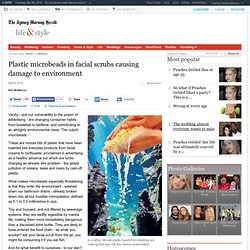
Vanity - and our vulnerability to the power of advertising - are changing consumer habits from breakfast to bedtime, and contributing to an almighty environmental mess. The culprit: microbeads. These are minute bits of plastic that have been inserted into everyday products from facial creams to toothpaste, proclaimed in advertising as a healthy advance but which are turbo-charging an already dire problem - the global pollution of oceans, lakes and rivers by cast-off plastic. What makes microbeads especially threatening is that they enter the environment - washed down our bathroom drains - already broken down into all-but invisible microplastics, defined as 0.1 to 0.5 millimetres in size.
Tiny and buoyant, and not filtered by sewerage systems, they are swiftly ingestible by marine life, making them more immediately dangerous than a discarded drink bottle. Advertisement Almost none. Why every company has a chemical footprint. What is your company's chemical footprint?
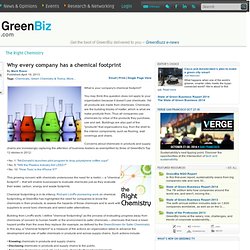
You may think this question does not apply to your organization because it doesn't use chemicals. Yet all products are made from chemicals. Chemicals are the building blocks of matter, which is what we make products from. US nuclear site fire 'was preventable' 14 March 2014Last updated at 19:49 ET The BBC's Jane O'Brien takes an underground tour of the nuclear waste site before the radiation leak Maintenance and safety lapses were at the root of a lorry fire that shut down the only US underground nuclear waste repository in February, a report says.
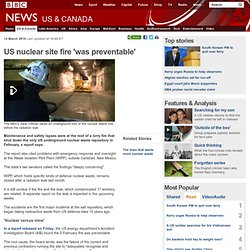
The report also cited problems with emergency response and oversight at the Waste Isolation Pilot Plant (WIPP), outside Carlsbad, New Mexico. The state's two senators called the findings "deeply concerning". WIPP, which holds specific kinds of defence nuclear waste, remains closed after a radiation leak last month. It is still unclear if the fire and the leak, which contaminated 17 workers, are related.
The accidents are the first major incidents at the salt repository, which began taking radioactive waste from US defence sites 15 years ago. 'Nuclear versus mine' In a report released on Friday, the US energy department's Accident Investigation Board (AIB) found the 5 February fire was preventable. Paris restricts car use after pollution hits high. State picks first products for 'green chemistry' screening. Long-banned chemical found in yellow dyes. Traces of polychlorinated biphenyl (PCB) 11—which belongs to a harmful group of chemicals banned in the 1970s—were found in yellow paints and dyes used in common items such as clothing and paper, according to new research from Rutgers University.
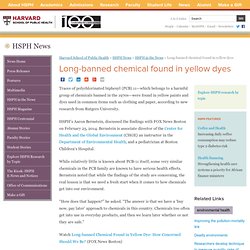
HSPH’s Aaron Bernstein, discussed the findings with FOX News Boston on February 25, 2014. Bernstein is associate director of the Center for Health and the Global Environment (CHGE) an instructor in the Department of Environmental Health, and a pediatrician at Boston Children’s Hospital. While relatively little is known about PCB-11 itself, some very similar chemicals in the PCB family are known to have serious health effects.
The Chemicals That Stick Around in the Body. Dirty dozen toxic chemicals in cosmetics and skincare products. Most cosmetics and skincare products have tons of toxic chemicals and harsh additives that have been linked to a wide range of chronic diseases.
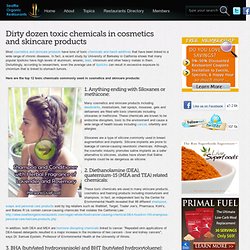
In fact, a recent study by University of Berkeley in California shows that many popular lipsticks have high levels of aluminum, arsenic, lead, chromium and other heavy metals in them. Disturbingly, according to researchers, even the average use of lipsticks can result in excessive exposure to chromium that is linked to stomach tumors. Here are the top 12 toxic chemicals commonly used in cosmetics and skincare products: Many cosmetics and skincare products including deodorants, moisturizers, hair sprays, mousses, gels and defoamers are filled with toxic chemicals including siloxanes or methicone. These chemicals are known to be endocrine disrupters, toxic to the environment and cause a wide range of health issues including cancer, infertility and allergies.
Scientists raise concerns over chemicals leaching into food from packaging. No one in their right mind would knowingly drink formaldehyde – but that’s the risk consumers take when they gulp down fizzy drinks sold in plastic containers, according to a report published Wednesday in the Journal of Epidemiology and Community Health.
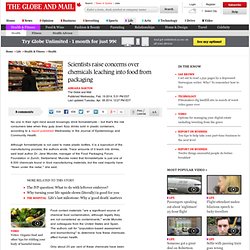
Although formaldehyde is not used to make plastic bottles, it is a byproduct of the manufacturing process, the authors wrote. Trace amounts of it leach into drinks, said lead author Dr. Jane Muncke, manager of the Food Packaging Forum Foundation in Zurich, Switzerland. Muncke noted that formaldehyde is just one of 6,500 chemicals found in food manufacturing materials, but the vast majority have “flown under the radar,” she said. Food contact materials “are a significant source of chemical food contamination, although legally they are not considered as contaminants,” wrote Muncke and colleagues from the United States and Spain.
News - China pollution: Beijing smog masks tallest building. Walmart Corporate Sustainability - Sustainable Chemistry Implementation Guide. Not logged in Login | Register Sustainable Chemistry Implementation Guide Purpose of Guide The purpose of this document is to provide direction and resources to suppliers so that they can easily and efficiently understand and achieve the goals of the Walmart U.S. and Sam's Club U.S.
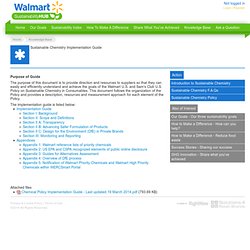
Policy on Sustainable Chemistry in Consumables. This document follows the organization of the Policy and provides a description, resources and measurement approach for each element of the Policy. The implementation guide is listed below: Attached files Chemical Policy Implementation Guide - Last updated 19 March 2014.pdf (793.69 KB) Action Also of Interest Privacy & Cookie Policy | Terms of Use ©2014 All Rights Reserved Powered By RightNow Technologies.